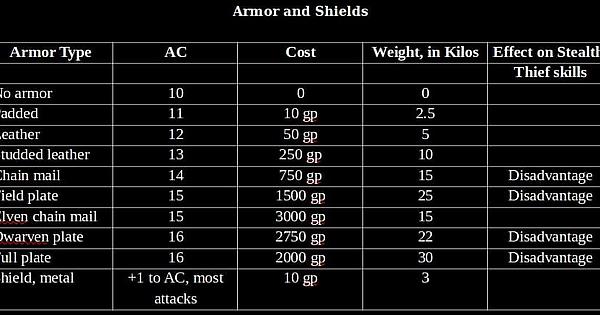EDIT: I messed up, changed Elven Chain to weigh 12 Kilos instead of 15.
I made the table above based on various editions of DnD as well as non DnD tables, I felt most armor tables were too! granular or not granular enough, the costs did not follow a very logical progression/value and above all Armor / AC values seemed really OP, like too high and as such too much of a killer feature. By that I mean it wouldn’t be too hard/long to get the gold and after that your fairly low level PC would almost never get hit by half of all common monsters, even if the monster tried attacking the player 3 or 4 or more times in one single combat. Simply put if you can get to AC 8 with just saving up gold or finding/buying nice armor, and then you add a Dex AC bonus of maybe +2 on top, and maybe a AC bonus buff +1 due to a spell by a friend, your 1 to 3rd level not even rich character is now at AC 21,… Which means that an average Orc, Gnoll, Kobold, wild animal etc etc, will almost never successfully land any hit, hence my table and values.
I like my battles, fast, furious and fairly deadly (in theory) since I like OSR, tbh in practice my ACs above likely don’t even necessarily mean that my game is more deadly or not much, only faster. (Battle is decided faster, characters decide if they have to run away or can prevail, faster). By that I mean is that all the ACs above are balanced/scaled!
So any NPCs or monsters they encounter that have Armor of the same type, will of course have the same AC! Consequently those NPCs are no less and no more hiteable than the PCs… I have also scaled natural armor of creatures and monsters to match my scale of +1 to ca +6, in other words it will be very rare that my players encounter a monster or adversary that has any AC bonus that is higher than that I have in the table, so also ranging from +1 to +6. This holds true, barring very magical or legendary beasts, which my players likely will only encounter once they are higher level and have big magical (AC) bonuses themselves.
I don’t find drawing out combat up to twice as long, with ca. 2x as many misses to really have much added value. The monsters will die / get hit faster too! with my AC system, so the net result is not that different and certainly not a death wish.
I spend some time reading the Chain mail and Plate mail (both were historically very expensive/valued even in the real world with our bit more advanced technology at the time) Wikipedia pages, to make sure my cost per type as well as the weights were sensible.
Wizards and Clerics can only wear/cast spells with armors that have ACs up to 14, (unless they are magical +1 or +2 versions of those base 14 and under AC armors, Elven chain mail likely will also work as almost Elven chain is magical to some degree, it is made to not interfere with spell casting). Thieves, in theory, can wear any armor if they have high enough STR but as the table shows it will be bad for their primary class skills = disadvantage on (almost) all their Thief skill rolls and Backstab / dexterity based attacks.
Elven chain is fantastically rare, takes a looong time to make and almost never sold, only earned or gifted, Dwarven plate is also very rare, but can be had if you have the coin and can find one of the very few Dwarven master armorers capable and willing to make it in non-dwarf sizes, and also takes a looong time to make. Special processes only a handful of craftsman know, zealously guarded metallurgic secrets and additives, and reputedly rare magic are used in these rarest of armors.
I purposefully didn’t want to go the way of having certain pieces (chest plate of instance) of armor in the table/making a very long table, I figure a DM can always assign those values on the fly, based on type, fit, condition etc, and by looking at this table it should give him a (very) good starting point for those situations and ACs any way
Anything you would do different?
If I look at my table as a Min Maxer Munchkin, i’d think to myself:
“Ah, so I get a shield and padded, that is +2 for a total of 12 AC and only costs me 20GP total instead of going for Leather which is 50GP! and gives me the same +2 / 12 AC!” xd
This is why shields are nowhere near as good as armor covering entire body,… breath weapon, acid splash, magical effect, arrows fired into melee, all of those and more might still (partially) hit you if you only have a shield and/or padded armor (under or over the shield, shield not up in time, eats through soft armor too easily) but how do I rule that without more hassle and die rolls…? Not sure at all…!



 Interesting about the broad/even armor types, had never though of that.
Interesting about the broad/even armor types, had never though of that.